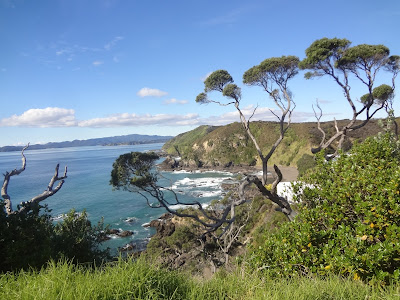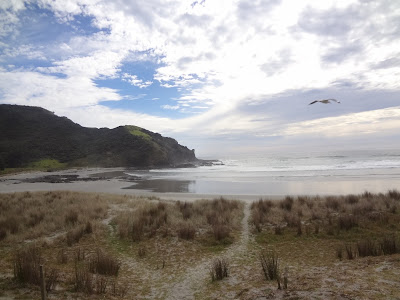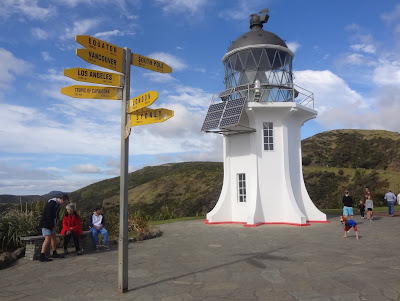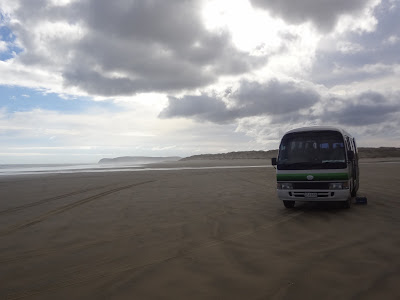I've had a complicated relationship
with that big blue backpack. There have been times where it's been an
awkward hump on my back, bulging with travel pamphlets, clothes,
toiletries, and an assemblage of odds and ends that never seemed like
much until it was all together. There were times when I outright
hated the thing, where it dug into my shoulders and I wished I could
fling it as far away as possible – walking in the wrong direction
in Taupo was one such time, and the ascent of the Kepler Track made
me understand why someone would go llama treking after all, to load
up one of those beasts of burden. But no matter how many times I
cursed that bag, it was the sole constant during a tumultuous 6
months. I got to know how to distribute the weight, where to put
things so they were accessible, and how to buckle my shoes and
sleeping bag onto the side so it was a complete package.
I spent my last few days in New Zealand
the only way I knew how – decompressing. Auckland is a big city,
and for the first time in a long time, I was afforded the luxury of
being completely anonymous. It was strange though, because I didn't want to do anything, but I had a hard time sitting still, either. I wanted to savour what I could, while wishing that time would hurry up and get a move on.
The Wellington Sea Shanty Society is
even better than it sounds – a duo, one playing the piano
accordion, the guitarist wearing a full sailor suit, both bellowing
out songs of the sea from the land Down Under. I walked up and down
the bar-lined strip of Posonby Road for close to two hours, searching
for the Golden Dawn – it ended up being a completely nondescript,
sweaty, shoulder-to-shoulder bar cut into an alcove. By the time the
band finished by jumping up on the bar and leading the audience in a
singalong of “Drunken Sailor” (they passed out a songbook
beforehand, not that I needed it for this one), I knew I would have
willingly spent another two hours looking for this place.
The dude who's sharing a squat room with
me slipped in not long after I got back, bringing a one night stand with him.
So that was a pretty comfortable sleep, with that going on about five
feet from my pillow (they had a good time anyway, by the sounds of it). How much do people shift around when they're actually asleep? I mused as I lay awake, leg cramped in some acrobatic contortion that I was forced to hold for a solid half hour, afraid that relaxing it would somehow make things more awkward than they already were. I would have willingly swapped for the folded
down backseat of a car that night.
I think it was sometime around mid-afternoon yesterday that I realized I needed to buy a few things – crap, no less, but I did promise Mom I'd get her a snowglobe. There are a congestion of souvenir shops in downtown Auckland, and they all sell the exact same merchandise, double as health supplement outlets, and are run by petite Asians who hover over you as soon as you cross the threshold, like a swooping hawk eyeing up a squashed possum in the middle of the road. It's a bit off-putting, but I was on a mission, so I ducked into them all. I even braved a comic book store, thinking I might find some knickknack there, in the bowels of the mall – when I went down the escalator, I was greeted by long rows of tables set up for playing Dungeons & Dragons or something, and a ripe asscrack as ominous as the iceberg must have looked to those guys on the lookout tower of the Titanic.
Anyway, I got the snowglobe.
I think it was sometime around mid-afternoon yesterday that I realized I needed to buy a few things – crap, no less, but I did promise Mom I'd get her a snowglobe. There are a congestion of souvenir shops in downtown Auckland, and they all sell the exact same merchandise, double as health supplement outlets, and are run by petite Asians who hover over you as soon as you cross the threshold, like a swooping hawk eyeing up a squashed possum in the middle of the road. It's a bit off-putting, but I was on a mission, so I ducked into them all. I even braved a comic book store, thinking I might find some knickknack there, in the bowels of the mall – when I went down the escalator, I was greeted by long rows of tables set up for playing Dungeons & Dragons or something, and a ripe asscrack as ominous as the iceberg must have looked to those guys on the lookout tower of the Titanic.
Anyway, I got the snowglobe.
Between that, I put in more than a few
new miles on my sneakers, which I think have to be officially retired
once I get home (assuming they make it that far). I sipped a frothy
flat white at a cafe while a guitar trio played laid back versions of
Tom Petty and Sting songs, and I had my last pie this afternoon (a chicken and mushroom one, beneath the glade at Albert Park).
Bye Pie (a haiku)
By R. Belbin
My mince and cheese pie
Flaky crust embrace with Wattie's
Mouth memory linger
I lingered for a few moments in the park, finishing my coffee and watching the people pass by, but when I stood up to throw my trash away and turned back, someone had already taken my spot on the bench. It was as if I'd never been there – this life moves on and nothing can be bottled to last forever. The arrivals gate was bursting with the clamour of newcomers, and it's their time now, my turn to gracefully step aside and move on, taking something important back with me (beyond the snowglobe). Some of what I'm bringing back hasn't even revealed itself yet, but I have no doubt there will come a time that I'll be able to trace everything back to a small Kiwi kernel that developed into something I could never imagine living my life without.
Soon they're going to call me for boarding. The sun has dipped below the horizon, running its course in the opposite direction as me, to reconvene somewhere high above the Pacific, west of Canada. There are a lot of things racing through my mind now, thought and memory and expectations of what is yet to be. As frustrating as it might be, I don't know if I'm ready to talk about New Zealand just yet – not until I've sorted it all out in my own head. Trust me on one thing though: it was all worth it. Everything.
East to go west.
Vancouver to stretch my legs, Montreal to put my contacts in and
brush my teeth. St. John's to get my feet firmly on the side of Cape
Spear I belong.
There's the
boarding call. This prodigal son is finally en route back home.
Cheers,
rb













































































